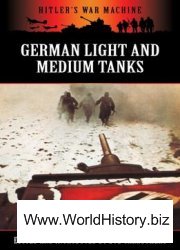At the outbreak of war a motorised infantry division was exactly that: a division that had been given trucks and therefore no longer had rely on the traditional method of‘foot and hoof’ for its mobility. However, in the summer of 1942 a number of the motorised infantry divisions were given a battalion of tanks, which greatly increased the division’s firepower. This rapidly became standard procedure. When the motorised divisions became panzergrenadier divisions in 1943 they were equipped with a single battalion of tanks or assault guns. In theory this gave the division a strength of 45 tanks or assault guns. The number of tanks dropped as the war went on, and they were replaced steadily by assault guns. Nonetheless, given the severe shortages of ec]uipmcnt a full strength panzergrenadier division might well have more armour than a depleted panzer division.
Elite formations such as the Grossdeutschland Panzer Grenadier Division were even stronger. This favoured division had four tank battalions and one assault gun battalion. The Waffen SS 1st, 2nd, 3rd and 5th Panzer Grenadier divisions had one regiment of tanks and one battalion of assault guns, which gave them the armoured strength of a strong panzer division.
Casualty replacements instead - a number of different tank types were employed.
In June 1942 the 103rd Panzer Battalion of 3rd Motorised Infantry Division contained the three standard German tanks of the period: the Pz Kpfws II, III and IV. The lightest of these was the Pz Kpfw II, which was also operated by the 116th Panzer Battalion of the 16th Motorised Division. By mid-1942 the small Pz Kpfw II was largely obsolete as it lacked firepower and decent armour. They were in the process of being phased out and their chassis were often converted to other uses.
¦ Pz KpfwIIAusfF
Crew: 3; Weight: 10,000kg (9.8 tons); Length: 4.64m (14ft); Width: 2.30m (7ft); Height: 2.02m (6.2fl); Armour: 35mm front, 20mm sides; Armament: 20mm cannon, 7.92mm MG; Powerplant: Maybach 6 cyclinder petrol engine - 140hp; Performance: Speed (road): 55 kmh, Range (road) 200km
Of much more combat utility was the Pz Kpfw 111 medium tank. It continued in production until the summer of 1943 and remained an important part of the panzer arm until much later. Both the 3rd Motorised and the 29th Motorised Divisions operated the Pz Kpfw III until they were destroyed in the battles around Stalingrad in late 1942 and early 1943.




 World History
World History









